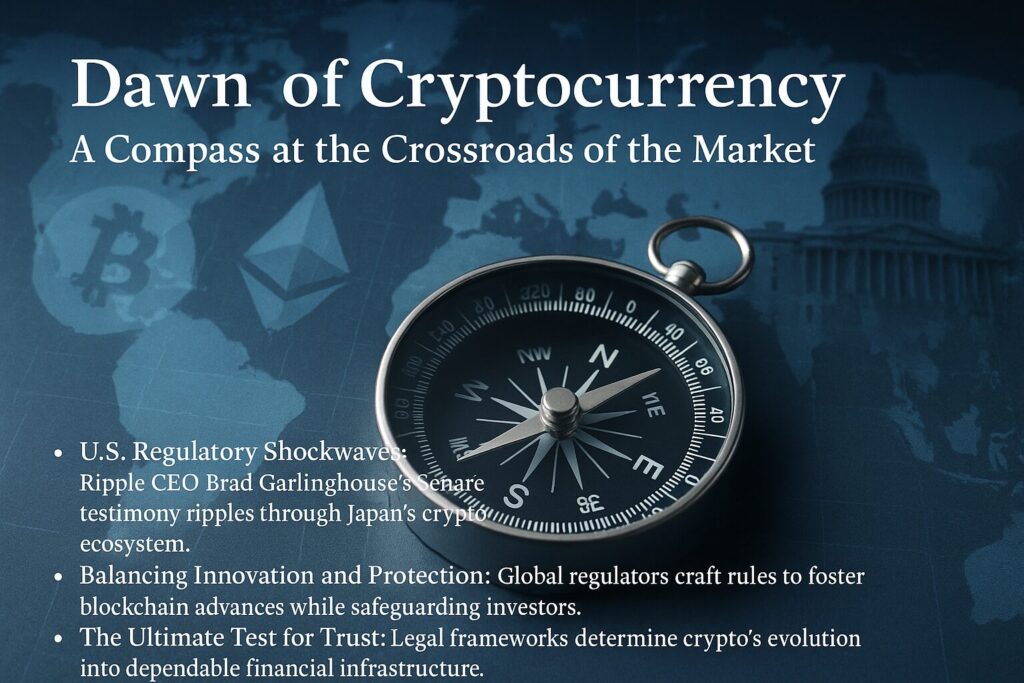
Main Points:
- U.S. Regulatory Shockwaves: Ripple CEO Brad Garlinghouse’s testimony in the Senate is sending ripples through Japan’s crypto ecosystem.
- Balancing Innovation and Protection: Global regulators grapple with crafting rules that foster blockchain advances while safeguarding investors.
- The Ultimate Test for Trust: Clear legal frameworks will determine whether crypto can evolve from speculative plaything into dependable financial infrastructure.
1. U.S. Regulatory Shockwaves and the Japanese Market
Subtitle: When Ripple’s Capitol Hill Appearance Becomes Tokyo’s Wake-Up Call
On July 9, 2025, Ripple CEO Brad Garlinghouse appeared before the U.S. Senate Banking Committee’s hearing titled “From Wall Street to Web3: Building Tomorrow’s Digital Asset Markets.” In his opening remarks, Garlinghouse warned that America’s lack of clear digital-asset rules had “prohibited meaningful progress” and called on lawmakers to establish a cohesive, principles-based framework for all players.
Although this debate unfolds in Washington, its shockwaves extend globally. Japan—long heralded for pioneering crypto regulation—may soon face pressure to align its own frameworks with U.S. precedents. For example, if the Senate clarifies that certain tokens qualify as securities, Japanese exchanges like bitFlyer and Coincheck could be compelled to revisit their listing criteria and compliance checks, potentially disrupting market liquidity and project launches.
Recent market data underscores how seriously investors take this hearing: XRP spiked as high as $2.40 on the day of the testimony—a 12 % rally from prior resistance at $2.38—underscoring bullish sentiment tied directly to regulatory optimism. Japanese traders, who often mirror U.S. sentiment, should prepare for increased volatility as Tokyo closely monitors America’s regulatory compass.
2. Carving a Path: Innovation and Protection
Subtitle: Crafting the Regulator’s Sword That Neither Stifles Progress Nor Fails Consumers
A consistent theme from witnesses—including Chainalysis’s Jonathan Levin and former CFTC Chair Summer Mersinger—was that digital assets defy neat categorization under existing securities laws, and that carving out rigid classifications risks stifling nascent use cases such as DeFi and stablecoins. Garlinghouse echoed this, urging a “flexible, adaptive oversight” jointly administered by the SEC and CFTC.
For Japanese policymakers, this presents both a challenge and an opportunity. On one hand, overzealous rules could undermine Tokyo’s thriving DeFi studios and stablecoin issuers by imposing onerous registration burdens. On the other hand, clearer guidelines may attract institutional capital that has historically shunned Asia’s regulatory gray zones. Indeed, Ripple’s recent custodial agreement with BNY Mellon—America’s oldest bank—signals institutional appetite for on-chain settlement rails.
A balanced approach might involve:
- Principles-Based Classification – Defining tokens according to function (e.g., payment, utility, governance) rather than static labels.
- Regulatory Sandboxes – Allowing controlled experiments for emerging technologies without full licensing requirements.
- Tiered Consumer Protections – Heightening oversight for retail offerings while granting professional investors more leeway.
By adopting such measures, Japan can both safeguard its retail market—now home to over 4 million active crypto accounts—and champion cutting-edge blockchain deployments, from cross-border payments to decentralized identity.
3. The Ultimate Test for Earning Trust
Subtitle: From Speculative Asset to Societal Mainstay
Crypto’s reputation has long been tarnished by extreme price swings and headline-grabbing scams. Yet, as Garlinghouse noted, more than 55 million Americans now participate in the digital-asset economy, which boasts a combined market cap north of $3.4 trillion. Similar adoption trends are visible in Japan, where major retailers are beginning to accept stablecoin settlements and municipal governments experiment with blockchain-based land registries.
True mainstream acceptance hinges on two pillars: legal stability and operational transparency. A transparent rulebook alleviates uncertainty for banks and corporations, fostering partnerships like SBI Holdings’ collaboration with Ripple. Meanwhile, transparency in on-chain data—publicly auditable yet privacy-preserving—builds user confidence.
Upcoming legislative milestones—a likely House vote on the GENIUS Act to regulate stablecoins next week, followed by Senate Agriculture Committee deliberations—will be decisive. Should these bills pass with clear jurisdictional boundaries, Japan’s regulators may feel emboldened to harmonize their own laws, ushering in an era where crypto sits firmly within the financial mainstream.
Conclusion
As Ripple’s Capitol Hill appearance illustrates, the crypto industry stands at a pivotal junction. For Japanese market participants—from developers to institutional investors—the message is clear: global regulatory clarity is both imminent and imperative. By closely tracking America’s evolving frameworks, engaging proactively with policymakers, and investing in robust compliance infrastructures, Japan’s crypto ecosystem can ensure it is not merely a passive observer but a co-author of the next chapter in financial technology.

